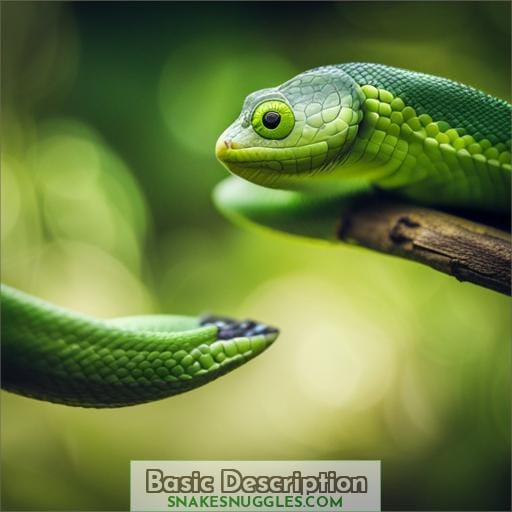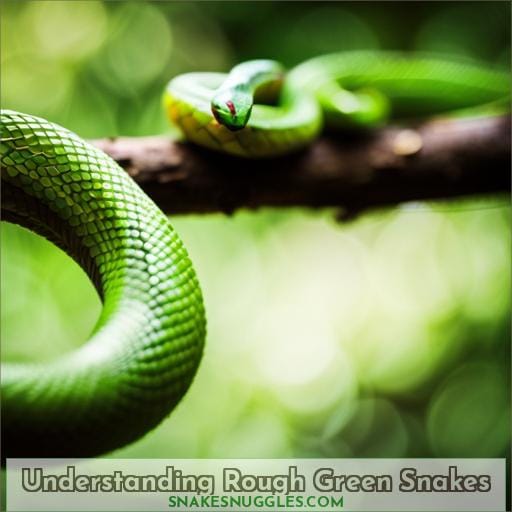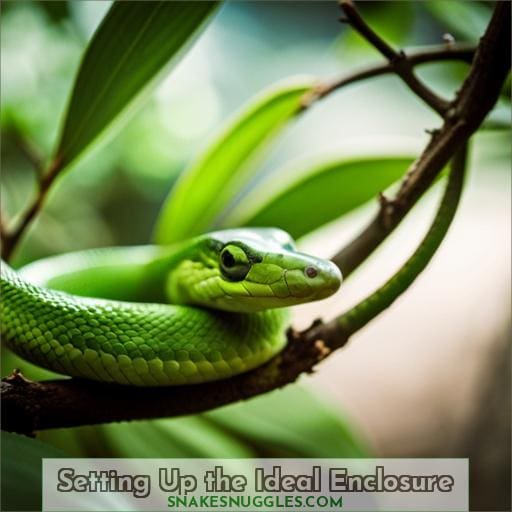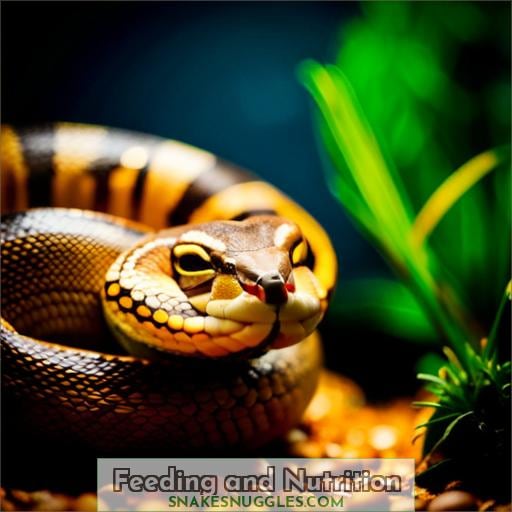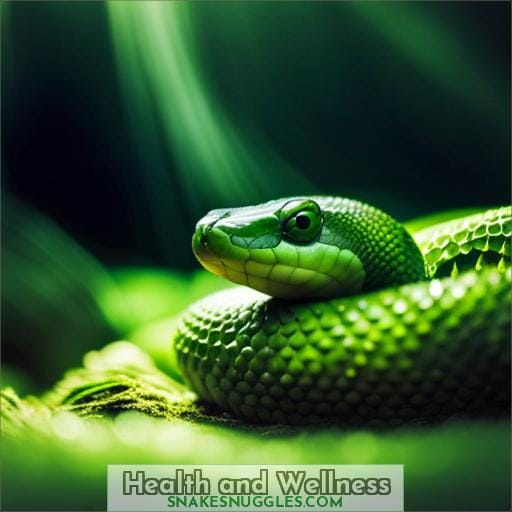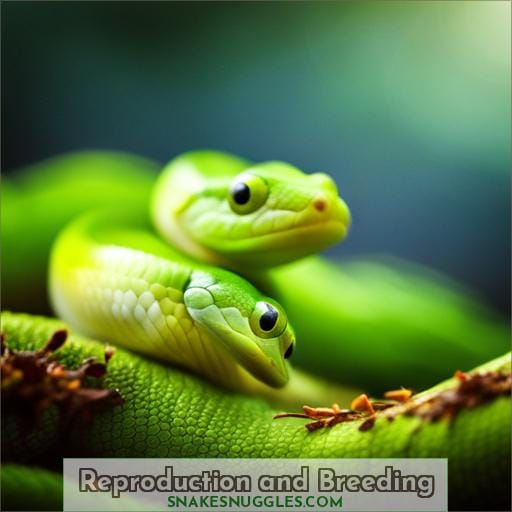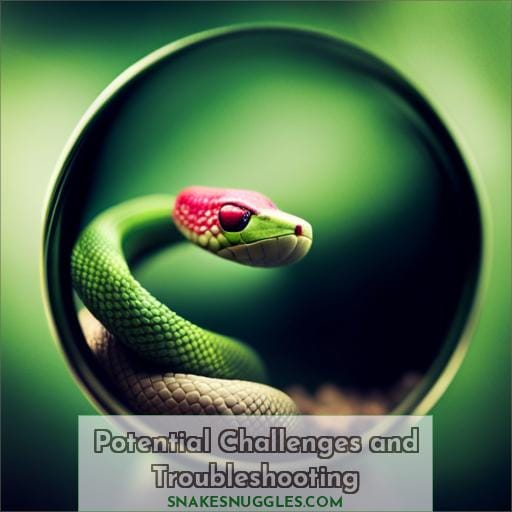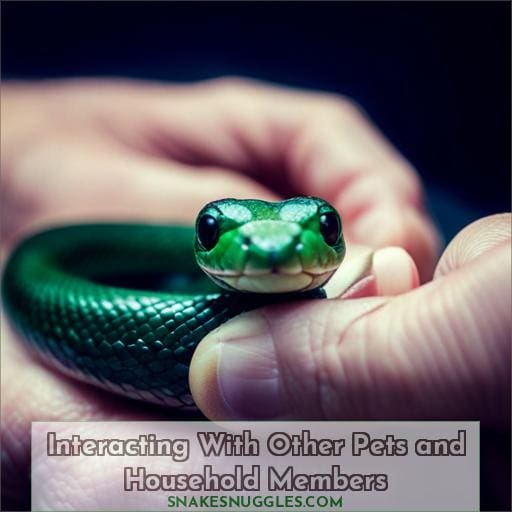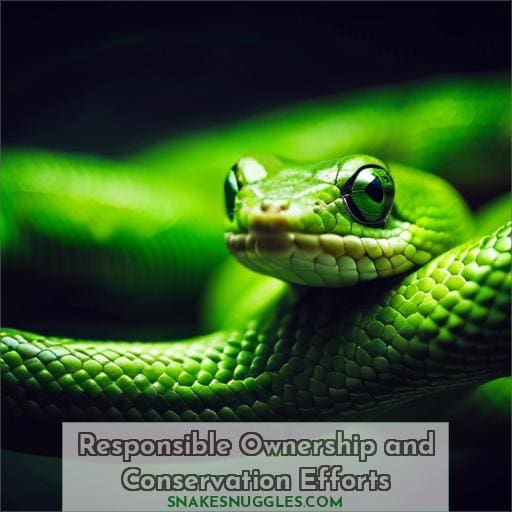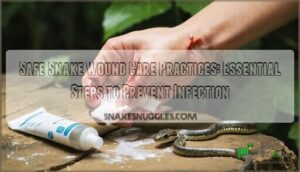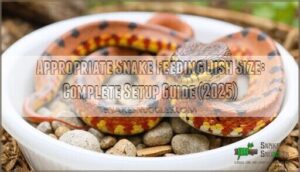This site is supported by our readers. We may earn a commission, at no cost to you, if you purchase through links.
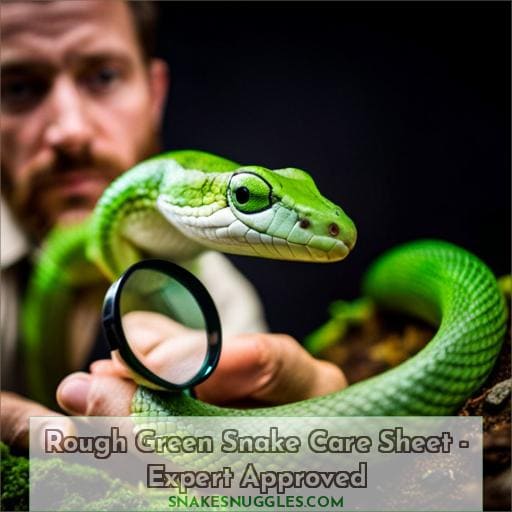 Get ready to become an expert in caring for Rough Green Snakes! In this comprehensive care sheet approved by a herpetologist, you’ll discover everything you need to know about providing the best possible care for these fascinating reptiles.
Get ready to become an expert in caring for Rough Green Snakes! In this comprehensive care sheet approved by a herpetologist, you’ll discover everything you need to know about providing the best possible care for these fascinating reptiles.
From their physical appearance and natural habitat to setting up the ideal enclosure and ensuring proper nutrition, we’ve got you covered. Whether you’re a seasoned snake owner or just starting out, this guide will help ensure the health and happiness of your Rough Green Snake companion.
Table Of Contents
- Key Takeaways
- Basic Description
- Understanding Rough Green Snakes
- Setting Up the Ideal Enclosure
- Feeding and Nutrition
- Handling and Bonding With Your Snake
- Health and Wellness
- Reproduction and Breeding
- Potential Challenges and Troubleshooting
- Interacting With Other Pets and Household Members
- Responsible Ownership and Conservation Efforts
- Frequently Asked Questions (FAQs)
- Are rough green snakes suitable for beginner snake owners?
- How often do rough green snakes shed their skin?
- Can rough green snakes be kept in the same enclosure as other snake species?
- Do rough green snakes require any special lighting in their enclosure?
- Are rough green snakes prone to any specific health issues?
- Conclusion
Key Takeaways
- Rough green snakes are diurnal and arboreal, requiring a tank with a minimum size of 20 gallons for juveniles and 36 inches in length and 24 inches in width for adults.
- It is important to maintain proper temperatures and humidity levels in the enclosure, with ambient temperatures of 75-85 degrees Fahrenheit during the day and a basking spot temperature of 85-90 degrees Fahrenheit.
- Rough green snakes should be fed a diet primarily composed of insects, such as crickets, grasshoppers, and spiders, and should be fed every 4 to 7 days, with portion sizes appropriate for their size and age.
- Regular veterinary care and check-ups are essential to ensure the well-being of rough green snakes, with annual visits to a herpetologist or reptile veterinarian recommended for preventive care and early detection of any potential health issues.
Basic Description
The rough green snake, also known as the Florida rough greensnake or simply green snake, is a non-venomous species found in Florida.
It’s characterized by its long and slender body, reaching lengths of 14-33 inches (35-82 cm).
Its vibrant bright green coloration sets it apart from other native snakes in Florida.
Physical Appearance
To properly care for a Rough Green Snake, it’s important to have a clear understanding of its physical appearance.
These snakes are known for their vibrant green coloration, which helps them blend into their arboreal habitats.
They typically have yellow or cream-colored bellies that extend up to their chin and lips.
With a sedentary lifestyle during the day, these visually striking snakes are diurnal and rely on keen eyesight to navigate their surroundings.
Natural Habitat
In their natural habitat, rough green snakes can be found in a variety of environments throughout the southeastern United States and northern Mexico.
They inhabit deciduous forests, fields, and shrubs where they display diurnal behavior and sleep coiled on branches at night.
These snakes feed exclusively on invertebrates like grasshoppers and spiders.
Rough green snakes are oviparous, laying 3-12 eggs per clutch in June-July.
Unfortunately, there’s been a decline in populations due to potential causes such as pesticide use and predation.
Understanding Rough Green Snakes
Now let’s delve into the behavior and temperament of Rough Green Snakes, as well as their lifespan and longevity. Understanding these aspects is crucial for providing proper care to these unique reptiles.
By gaining insight into their natural behaviors, you can create an environment that promotes their health and well-being. Additionally, knowing how long they typically live will help you plan for the commitment involved in keeping them as pets or observing them in the wild.
Behavior and Temperament
Get to know the behavior and temperament of Rough Green Snakes so you can understand your pet better.
These shy, solitary creatures are diurnal and arboreal, meaning they’re active during the day and prefer to live in trees.
With a limited lifespan averaging around 5-8 years, these snakes exhibit solitary behavior but may engage in communal egg-laying. Understanding their social behavior is essential for providing proper care in their habitat.
Lifespan and Longevity
As you care for your Rough Green Snake, it’s important to understand their lifespan and longevity.
On average, these snakes have a lifespan of about 8 years in captivity, with a maximum lifespan of around 10 years.
They reach maturity at around 3 years old and can start breeding as early as 2 years old.
With proper care including UVB lighting and seasonal breeding conditions, you can expect a life expectancy of approximately 5 to 8 years for your pet snake.
Setting Up the Ideal Enclosure
To ensure the well-being of your rough green snake, it’s essential to set up the ideal enclosure.
This involves providing a tank that’s appropriately sized and has proper dimensions for your snake’s comfort and movement.
Additionally, you need to maintain optimal temperature and lighting conditions within the enclosure, as well as ensuring adequate humidity levels and access to fresh water for hydration.
Tank Size and Dimensions
When considering the ideal enclosure for your rough green snake, it’s important to determine the appropriate tank size and dimensions.
- Minimum Tank Size: A minimum tank size of 20 gallons is recommended for juvenile snakes.
- Optimal Height: The height of the enclosure should be at least 18 inches to accommodate their arboreal nature.
- Recommended Length and Width: For adult rough green snakes, a tank with dimensions of 36 inches in length and 24 inches in width is recommended.
- Enclosure Requirements: Ensure that the lid is secure as these diurnal snakes are excellent climbers.
By providing a spacious and suitable environment, you can ensure the well-being of your captive-bred rough green snake.
Temperature and Lighting Requirements
To ensure the optimal conditions for your Rough Green Snake’s health and well-being, it’s important to carefully consider the temperature and lighting requirements in their enclosure.
Maintaining proper ambient temperatures of 75-85 degrees Fahrenheit during the day, with a basking spot temperature of 85-90 degrees Fahrenheit, is crucial for their thermoregulation.
Providing UVB lighting at a range of 10%-12% ensures they receive adequate visual and metabolic benefits.
Additionally, maintaining night time temperatures between 65-75 degrees Fahrenheit helps simulate natural hibernation periods necessary for their overall well-being.
| Temperature Requirements | Lighting Requirements |
|---|---|
| Ambient Temps: | Day Length: |
| – Range from 75-85°F | – Approximately 12 hours |
| – Basking Spot Temp: | – Provide UVB |
| – Range from 85-90°F | – Light |
Humidity and Water Needs
Maintaining proper humidity levels and providing access to fresh water are essential for the health and well-being of your rough green snake.
To ensure adequate humidity, mist the enclosure daily using a spray bottle.
Additionally, provide a shallow water bowl that’s large enough for your snake to soak in if desired.
Monitor the humidity levels regularly using a hygrometer and adjust as needed by adding or removing substrate or adjusting ventilation in the enclosure.
Proper hydration is crucial for healthy shedding, so be sure to always have fresh water available for your snake’s needs.
Feeding and Nutrition
Now let’s delve into the feeding and nutrition requirements of rough green snakes.
These snakes have a diet primarily composed of insects, such as crickets, grasshoppers, and spiders. It’s important to provide a varied diet to ensure they receive all necessary nutrients.
Feeding should occur every 2-3 days for juveniles and every 7-10 days for adults, with portion sizes appropriate for their size and age.
Diet and Food Preferences
To properly care for your rough green snake, it’s important to understand their diet and food preferences.
- They eat a variety of prey items, including insects and spiders.
- Some owners prefer to feed live prey, while others opt for frozen options.
- Gut-loaded prey (prey that has been fed nutritious meals) can provide essential nutrients.
- Rough green snakes should be fed every 4 to 7 days, depending on the age and size. The amount of food should be proportionate to the snake’s body size.
Feeding Schedule and Portion Sizes
Now let’s talk about the recommended feeding schedule and portion sizes for your Rough Green Snake.
It’s important to provide the right amount of food at appropriate intervals to ensure your snake stays healthy.
For hatchlings, feed them every 3 days with baby mice as whole prey items.
As for adults, they can be fed every 5-7 days with adult mice as pre-killed prey items.
Remember to thaw frozen mice before feeding them to your snake.
| Age Group | Feeding Schedule |
|---|---|
| Hatchlings | Every 3 days |
| Adults | Every 5-7 days |
Handling and Bonding With Your Snake
When it comes to handling and bonding with your rough green snake, proper techniques are essential.
Building trust and establishing a bond with your snake requires patience, consistency, and gentle handling.
By respecting their natural behavior and providing a comfortable environment, you can create a positive relationship that allows for safe interaction between you and your snake.
Proper Handling Techniques
When handling your rough green snake, gently support its body to ensure a secure and comfortable grip.
Slow movements are key in establishing trust with your snake. Take the time to observe their behavior and communicate through gentle touch. By understanding their perception, you can build a bond based on mutual respect and safety.
It’s important to note that rough green snakes play vital ecosystem roles as insectivores but currently have no specific conservation status.
- Support the body for a firm grip
- Avoid sudden movements
- Maintain a calm demeanor
- Use slow movements when handling
- Observe communication cues between you and your snake
Building Trust and Establishing a Bond
Although rough green snakes aren’t generally handlable pets, you can still build trust and establish a bond with consistent, gentle handling over time.
It requires patience and repetition to help your snake become accustomed to human touch.
Start by offering your snake a safe environment where it feels secure.
Gradually introduce tactile interactions through short handling sessions, increasing the duration as the snake becomes more comfortable.
Building trust takes time but will ultimately lead to a stronger bond between you and your pet snake.
Health and Wellness
When it comes to the health and wellness of your rough green snake, there are a few common health issues that you should be aware of.
Regular veterinary care and check-ups are essential to ensure the well-being of your pet. By staying proactive in monitoring their health and seeking professional advice, you can help prevent potential problems from arising and maintain optimal care for your rough green snake.
Common Health Issues
If your rough green snake experiences any health issues, it’s important to address them promptly and seek appropriate veterinary care.
Common health issues that may affect rough green snakes include:
- Dehydration
- Respiratory infections
- Mouth rot
- Scale rot
- Tail rot
Dehydration can occur if the snake doesn’t have access to a sufficient water source.
Respiratory infections can be caused by poor husbandry conditions or exposure to pathogens.
Mouth rot, scale rot, and tail rot are all potential bacterial infections that require prompt treatment from a veterinarian familiar with reptile care.
Regular Veterinary Care and Check-ups
To ensure the overall health and well-being of your Rough Green Snake, it’s crucial to regularly take them for veterinary check-ups.
Annual visits with a herpetologist or reptile veterinarian are recommended for preventive care and early detection of any potential health issues.
These regular check-ups allow for prompt treatment options if necessary, ensuring that your snake receives the best possible care.
While there may be some cost involved, investing in regular veterinary care is essential for maintaining the long-term health of your Rough Green Snake.
Reproduction and Breeding
Now let’s explore the fascinating aspects of rough green snake reproduction and breeding.
- Their mating behavior and seasonality
- The incubation process
- The care of hatchlings
Understanding these crucial elements will provide valuable insights into successfully maintaining a healthy population of rough green snakes in captivity or in their natural habitat.
Mating Behavior and Seasonality
Now let’s delve into the mating behavior and seasonality of rough green snakes, exploring their reproductive habits and breeding patterns.
Rough green snakes exhibit courtship displays during the spring mating season, which typically begins in early summer.
After successful copulation, females will lay eggs in late summer. The hatchlings then emerge in early fall, completing their unique cycle of reproduction.
Egg Incubation and Care of Hatchlings
Continuing from the previous discussion on mating behavior and seasonality, you’ll now learn about how rough green snakes incubate their eggs and care for the hatchlings.
Rough green snake eggs require specific conditions for successful incubation, including:
- Maintaining a consistent temperature of around 80-85°F (26-29°C)
- Turning them regularly to prevent sticking
- Humidity levels should be kept moderate, around 50-60%
Once hatched, hatchlings should be housed in an appropriately sized enclosure and fed a diet consisting of small insects like fruit flies or pinhead crickets.
Potential Challenges and Troubleshooting
Now let’s address some potential challenges and troubleshooting tips when caring for rough green snakes.
One common issue is shedding difficulties, which can occur if the humidity levels in their enclosure aren’t optimal or if there are any underlying health issues. It’s important to provide a proper shedding environment and monitor your snake closely during this process.
Additionally, we’ll discuss behavioral issues that may arise and possible solutions to ensure the well-being of your rough green snake.
Shedding Difficulties
When caring for your Rough Green Snake, you may encounter shedding difficulties. These challenges can include:
- Stuck shed
- Skin problems such as dehydration and dry skin
To troubleshoot these issues, ensure proper enclosure humidity to prevent inadequate moisture levels that can lead to dry skin. Additionally, check for improper heat sources that could contribute to dryness and lack of water availability leading to dehydration in your snake’s environment.
Behavioral Issues and Solutions
If you encounter behavioral issues or challenges while caring for your rough green snake, there are several solutions that can help address them.
Biting and hissing may occur if the snake feels threatened or stressed, so it’s important to handle them gently and give them time to acclimate.
Hiding is a natural behavior, but provide plenty of hiding spots in their enclosure.
If escape attempts become frequent, ensure the tank is secure.
Aggression can be addressed by identifying any potential triggers and providing a calm environment for your snake.
Interacting With Other Pets and Household Members
When it comes to interacting with other pets and household members, there are a few important points to consider.
First, always introduce your rough green snake slowly and gradually to any potential companions.
It’s crucial to prioritize the safety of all animals involved by providing proper supervision during interactions.
Introducing Your Snake to Other Animals
To ensure a safe and harmonious environment for your rough green snake, it’s important to consider how to introduce them to other animals in your household.
Follow these tips when introducing your snake:
- Introduce gradually, allowing time for adjustment.
- Avoid surprises or sudden encounters.
- Supervise interactions between the snake and other pets.
- Start with small animals before progressing to larger ones.
Remember to provide hiding places for both the snake and other animals.
Safety Precautions and Supervision
To ensure the safety of both your rough green snake and other pets or household members, it’s important to take necessary precautions and provide proper supervision during interactions.
- Keep hands away from the snake’s mouth to avoid bites.
- Always supervise children when they’re near the snake or any other pet.
- Make sure your rough green snake is in a secure enclosure before allowing interaction with other animals.
Use caution and prioritize everyone’s safety at all times.
Responsible Ownership and Conservation Efforts
When it comes to responsible ownership of rough green snakes, there are a few important considerations.
First, it’s crucial to be aware of any legal requirements or permit regulations in your area that may apply to keeping these snakes as pets.
Additionally, supporting conservation initiatives can play a vital role in ensuring the long-term survival and protection of this species in its natural habitats.
By being informed and actively participating in these efforts, you contribute to the responsible ownership and preservation of rough green snakes.
Legal Considerations and Permit Requirements
Before bringing home a Rough Green Snake, it’s important to be aware of the legal considerations and permit requirements associated with responsible ownership and conservation efforts.
Local ordinances and state laws may impose ownership restrictions, requiring permits for keeping these snakes.
Additionally, interstate transportation of Rough Green Snakes may require specific permits from the USDA.
It’s crucial to adhere to CITES regulations and wildlife protection laws to ensure the conservation of this species in captivity.
Supporting Conservation Initiatives
Supporting conservation initiatives is essential for responsible ownership of rough green snakes and contributes to the preservation of their natural habitats.
By actively participating in:
- Community outreach
- Education programs
- Fundraising efforts
- Advocacy campaigns
- Habitat restoration projects
you can make a positive impact on the conservation of these fascinating reptiles.
Through raising awareness about their importance in ecosystems and promoting sustainable practices, we can ensure the long-term survival of rough green snakes and protect their fragile habitats from further destruction.
Frequently Asked Questions (FAQs)
Are rough green snakes suitable for beginner snake owners?
Yes, rough green snakes are suitable for beginner snake owners.
They’re non-venomous, non-aggressive towards humans and pets, and easy to care for.
With their unique bright green coloration, they make an interesting addition to any reptile collection.
How often do rough green snakes shed their skin?
Rough green snakes shed their skin approximately every 4-6 weeks.
Shedding is a natural process for snakes to accommodate growth and replace worn-out skin.
It’s important to provide proper humidity levels and objects for them to rub against during shedding.
Can rough green snakes be kept in the same enclosure as other snake species?
Rough green snakes shouldn’t be kept in the same enclosure as other snake species due to potential conflicts and stress. It’s recommended to house them separately to ensure their well-being and minimize any risk of harm.
Do rough green snakes require any special lighting in their enclosure?
Ensure proper lighting for your rough green snake’s enclosure.
Provide a combination of UVB and UVA light to simulate natural sunlight, promoting their overall health and well-being.
Monitor temperature levels to ensure optimal conditions for your pet’s success.
Are rough green snakes prone to any specific health issues?
Rough green snakes are generally hardy and not prone to specific health issues.
However, like any pet, they can be susceptible to stress-related conditions or parasites.
Regular check-ups with a reptile veterinarian is recommended for overall well-being.
Conclusion
To ensure the health and happiness of your Rough Green Snake, it’s crucial to provide the proper care and environment.
By following this expert-approved care sheet, you’ll have all the information you need to create the ideal enclosure, understand their behavior, and meet their nutritional needs.
From setting up the perfect tank to handling and bonding with your snake, this comprehensive guide covers everything.
With the knowledge gained from this care sheet, you’ll be well-equipped to provide the best care for your Rough Green Snake companion.

